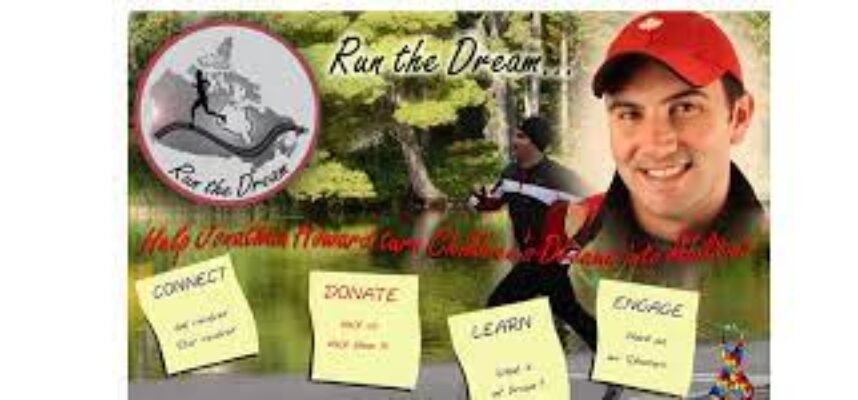22 Mar 2008
0 CommentsRUN THE DREAM: Social Entrepreneurism Par Excellence
 On Thursday, I attended the pre-launch party for what is an exciting new social enterprise. The guest of honour, Jonathan Howard, a 24 year old (and, I am proud to say, my nephew), is embarking on an extraordinary quest. On Tuesday, 25 March he will, in his RunTheDream charity fundraiser, do what most of us wouldn’t ever even consider attempting – to run across Canada, a distance of over 9 000 km from St. John’s to Victoria.
On Thursday, I attended the pre-launch party for what is an exciting new social enterprise. The guest of honour, Jonathan Howard, a 24 year old (and, I am proud to say, my nephew), is embarking on an extraordinary quest. On Tuesday, 25 March he will, in his RunTheDream charity fundraiser, do what most of us wouldn’t ever even consider attempting – to run across Canada, a distance of over 9 000 km from St. John’s to Victoria.
Why has Jonathan undertaken this amazing, and many of us would say impossible, run? Well, besides proving to himself that he can, Jonathan who is already an accomplished athlete and marathon runner, has had this personal goal since his university days. And, even more importantly, he hopes to raise significant funds for Autism Society of Canada, a rapidly emerging cause, yet one that still lags some of the bigger charities in its awareness and fundraising. In addition to a significant fundraising objective, a CSF for Jonathan’s will be to significantly increase awareness of the Autism Spectrum Disorders across Canada.
How can you help Jonathan raise his (minimum) goal of $2.5 million? The website at http://www.runthedream.ca will be launched on Tuesday March 25th, and in addition to regularly updated progress reports, online donations can be made on this site, or printable forms for mailing purposes are also provided. Alternatively, any Canadians can email from their online banking portal to “mydonation@runthedream.ca”. Please give generously, however you choose to donate.
One of my personal favourite quotes to characterize the exceptional nature of entrepreneurism is:
“Entrepreneurism – making the impossible merely difficult”
This surely applies to Jonathan’s demonstrated passion to embark on a task that 99.999% of us would view as impossible. And, part of achieving the impossible is the creation of a great “social enterprise” in RunTheDream, having startup metrics like:
- Year one revenue (contributions) target of $2.5 million (which very few technology startups aspire to, let alone achieve
- 8 month run timeline, but probably almost two years of activities planned from conception to completion
- corporate partners, like Telus, MuchMusic, Gatorade, Landmark Sport Group & Spa Sensations
- a “board” & management group of about 15 core individuals doing everything from public relations, event planning, logistics, business development and partnering, etc.
- and, like most technology startups, Jonathan and the team have developed this using years and months of passionately dedicated “sweat equity”
So, by these measures, this a not “your father’s” approach to charity or nonprofit and, I remain excited how the passionate entrepreneurism of remarkable individuals like Jonathan Howard, continue to transform our society in very positive ways. We all wish Jonathan good luck in embarking on his trans-Canada odyssey.



28 Mar 2008
0 CommentsFounderitis: Black Hats versus White Hats
As a serial entrepreneur, investor and (ex-)founder in technology startups, I have seen more than my share of experiences showing how fraught founder interactions can be. My friend J Paul Haynes, who is a serial executive (and founder), showed me an interesting article from the February 2008 issue of Harvard Business Review on this topic entitled “The Founder’s Dilemma”. In this article, Noam Wasserman analyzed 212 startups and observed some intriguing patterns. What is great about this article is that it provides a cold, analytic economic framework to assess the “founder’s dilemma” which is the “… choice between making money and controlling the business.” The Faustian bargain to give up equity and control in order to attract institutional (venture) capital that will grow the business faster is a hard one for many founders to accept. And yet, the leverage of external capital and talent typically goes hand in hand with technology startups.
Wasserman goes on to show that founders, who want to retain control, often choose (or are forced to accept) slower growth and less chance of making money in a “home run” exit. Conversely, the study almost paints a picture of the inevitability of founders being pushed out by investors. For most founders, it makes grim reading, while most VCs would simply nod knowingly at the picture of founder limitations. After all, many of those terms in the much vaunted VC term sheets (now often term books!) evolved precisely as defensive artillery trained on errant founders. The article’s implication that the half life of the CEO tenure founders is short, will make difficult reading for most founders.
Perhaps it is difficult for founders to excel at both and so they “… end up being neither rich nor king”, but I would hope to see less of a zero sum game and more scope for personal growth. Personally, I find most founders I encounter to be smart and compelling individuals. Of course, I’ve also seen many of the counterproductive traits and habits that the VCs pejoratively label “founderitis”. On balance, I’m mostly on the side of founders in this classic standoff between the “black hats” (VCs) and “white hats” (founders). Having said that, I’ve also founders pull some appalling stupid and counterproductive moves in my time.
Since most founders are super smart and highly motivated individuals, with better mentoring, role models and better expectation setting by all parties, I would like to believe that more founders could better integrate the “rich” and “king” parts. In other words, I would hope to see more founders figure out how to increase their management and team playing skills, while also building value in their businesses.
As I mentioned, I think founders are, as a whole, a creative, exciting and group worth celebrating. Therefore, to balance Wasserman’s HBR research, I’d encourage everyone to read the remarkable 2007 book Founders at Work by Jessica Livingston. In it, she endeavoured to analyze founders by interviewing 32 founders from the 1980’s and onward, from hardware, to software, to Web 2.0 she has deduced some interesting patterns of founders:
While it is easy to imagine the “blindspots” and self promotion inherent in interviews with founders, the sheer number of founders that Ms. Livingston interviewed helps to mitigate this concern over a wide range of time and types of technology businesses. And, for those who think the MBAs and marketers rule the world, it is refreshing to see the Silicon Valley model of very strong technical founders celebrated.
So, here’s to those remarkable individuals, the entrepreneurs founders who have the courage and tenacity to start business. For all their shortcomings and big egos, we do need to celebrate their important role in venture creation.